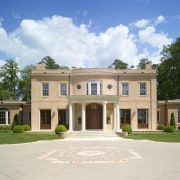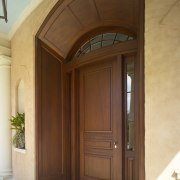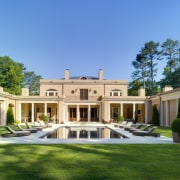Subtle graces
This dramatic yet understated Regency design celebrates form and transcends time
Good taste travels well, runs the adage, and this could well apply to the bold architecture from the English Regency period. Since gaining popularity in the United States during the 1800s as the Federal style, the Regency look has successfully negotiated borders of time as well as geography its strong forms with minimal detailing well suited to modern decors.
This grand residence, designed by architects Gregory Palmer and Derek Hopkins of Harrison Design Associates, with interior design by James Howard, is an accurate example of the Regency aesthetic. True to style, the impressive facade only tells half the story of the expansive 11,000sq ft home, which has wings on both sides enclosing loggias, a pool and garden at the rear.
"Simple, formal symmetry and an absence of excessive ornamentation are two hallmarks of a Regency home following on from the earlier Georgian style," says Palmer. "In addition, Regency style came at a time when the deeper antiquities of Pompeii had only just been unearthed and so it was also noted for its renewed interest in both Roman and Grecian classical forms."
Because Regency style avoids prominent ornamentation, it allows the scale, balance and proportions of the structure to shine through. Similarly, brick facades are plastered to heighten focus on the period architecture's uncluttered, monolithic forms.
"This Regency design follows a five-part plan comprised of the main block, two hyphens, or connecting wings, and the wings proper," says Palmer.
The facade's balanced symmetry draws the eye to the entrance portico, complete with four classical columns. Their understated treatment brings a lightness to the home's formal mass.
"While the stone Doric columns of antiquity are echoed in wood on both the exterior and interior of Regency houses, they are usually given a more slender treatment better suited to the material," says Hopkins. "These pared-back yet impressive forms provide an intimation of the balanced, restrained interiors to come."
In the entry foyer, a Grecian medallion inset in the grey and buff squares of the limestone floor and a frieze in a Greek key pattern are other favored Regency devices. The dining room and study lead off this space to the right and left while straight ahead, a circulation gallery takes guests to the formal salon, or great room.
"The salon stands at the heart of the home, and reflects the restrained decor typical of this architecture," says James Howard. "The absence of undue ornamentation means the Regency style presents an ideal backdrop for art and clean-lined furniture settings."
A Greek frieze appears again in this formal space, while pale wall colors and a light, airy ambiance also reflect key Regency values.
The public rooms of a Regency design are the most formal, with more relaxed interiors seen in the private spaces to the rear of the design.
James Howard designed the architectural detailing for the rooms to fit the Regency style. However, in terms of the interior design, the owner wanted a more contemporary feel.
In response, Howard designed understated pieces for the interior, such as the console in the study, and introduced modern wall finishes a silver-leaf grass paper in the same room.
"The Regency style works well in modern decors," says Howard. "Here, the solid, clean wall surfaces are as effective a complement for the solid Moderne furniture as they are for more classic elements such as the wingback chairs, that were popular when the style was created."
Outside, to the rear, two loggias are tucked into the wings of the house, acting as outdoor rooms overlooking the large pool.
"The corners of the loggias are finished in broad pilasters," says Palmer. "Most columns elsewhere are slender, but these pilasters have a more substantial look to give presence balance is a key factor in the design."
With its understated aesthetic, the house makes a graceful setting for today's furniture, furnishings and artworks a happy marriage of classic form and modern function.
Credit list
Interior designer
Structural engineer
Siding
Kitchen manufacturer
Faucets
Refrigeration
Landscape design
Builder
Floors
Kitchen sink
Oven, coooktop, warming drawers
Dishwasher
Story by: Charles Moxham
Photography by: John Umberger
Home kitchen bathroom commercial design
Connected to the ocean
Simplified seclusion
At one with the Amazon
















